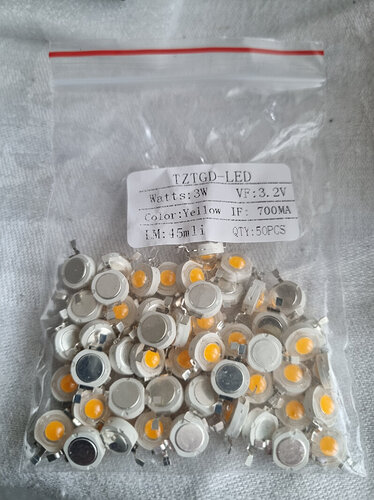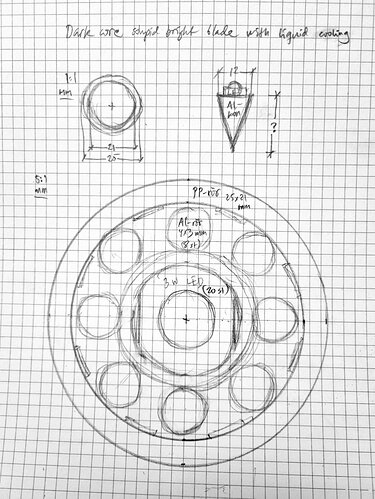At the moment, this is just an idea, but I’m planning to build it, and I’m waiting for material to arrive by mail.
I want a saber that is painfully bright to look at. Ideally, it should have enough power to look bright even in full daylight.
Also, the “dark core” effect would be cool.
This build will try to combine the two for mutual benefit.
I want to cram as many as I can of these 3W LEDs into a blade:
For this to work, I need heatsinks for the LEDs in the form of a chunk of aluminium for each to sit on, and I also need active cooling because they are all sealed in a narrow tube. This sketch outlines what I have in mind:
The blade tube is transparent, with LED chips mounted in a stack, with a cage of 8 4mm aluminium pipes around them. Between these pipes, on the inner wall of the blade tube, are reflective strips (drawn but not marked in the sketch) to block all direct views of the LED at the centre from the outside. The light that escapes is reflected from the inner face of the narrow pipes and escapes only (well, mainly) at glancing angles. This will create a “dark core” effect, hopefully, where the blade has a dark centre with a bright corona around it. Each LED is mounted on the flat base of a short circular cone of solid aluminium, for heatsinking and for making the light from the adjacent LED that would hit the chip from below be reflected outwards. I think the profile of that cone can be designed to get a recently uniform intensity along the blade for a certain spacing of the LEDs. I’m thinking one LED per inch or thereabouts, which makes the uniformity less of an issue.
The pipes carry a cooling medium (air, or, if thermal issues become severe, water) to the top of the blade, and also serve as conductors for the power, allowing for a segmented blade with seven sections without adding any wires. A 4mm aluminium tube can carry a lot of current. If air cooling is enough, the hilt can just act as a blow dryer and expel the hot air. Should liquid cooling be required, which I hope it won’t, it will be a challenge to fit the heat exchange radiator in the hilt along with the circulation pump and the power source. I hope air cooling will suffice.
The design limits here will be thermal management (cooling dozens of 3W LED chips enclosed in a tight space) and power (with 1 LED per inch, a full blade will consume almost 100W). There are Li-Po power packs for RC purposes that will fit in a standard hilt and would last for 10-20 minutes at full power. In normal circumstances, I expect the blade can be run at reduced power and still be stupid bright.
I will post updates here once the material arrives and I can build prototypes. If you don’t hear from me, it means real life interfered with my play time and I haven’t found the time to build anything yet. I will post any results, even reports of miserable failure. Because science.

